The Fifth Element
5.6 /10 3 Votes
71% Rotten Tomatoes 52% Metacritic Genre Action, Adventure, Sci-Fi Duration Language English | 7.6/10 IMDb 3/4 Roger Ebert Costume design Jean Paul Gaultier Country France | |||||||||||||||||||||||||||||||||
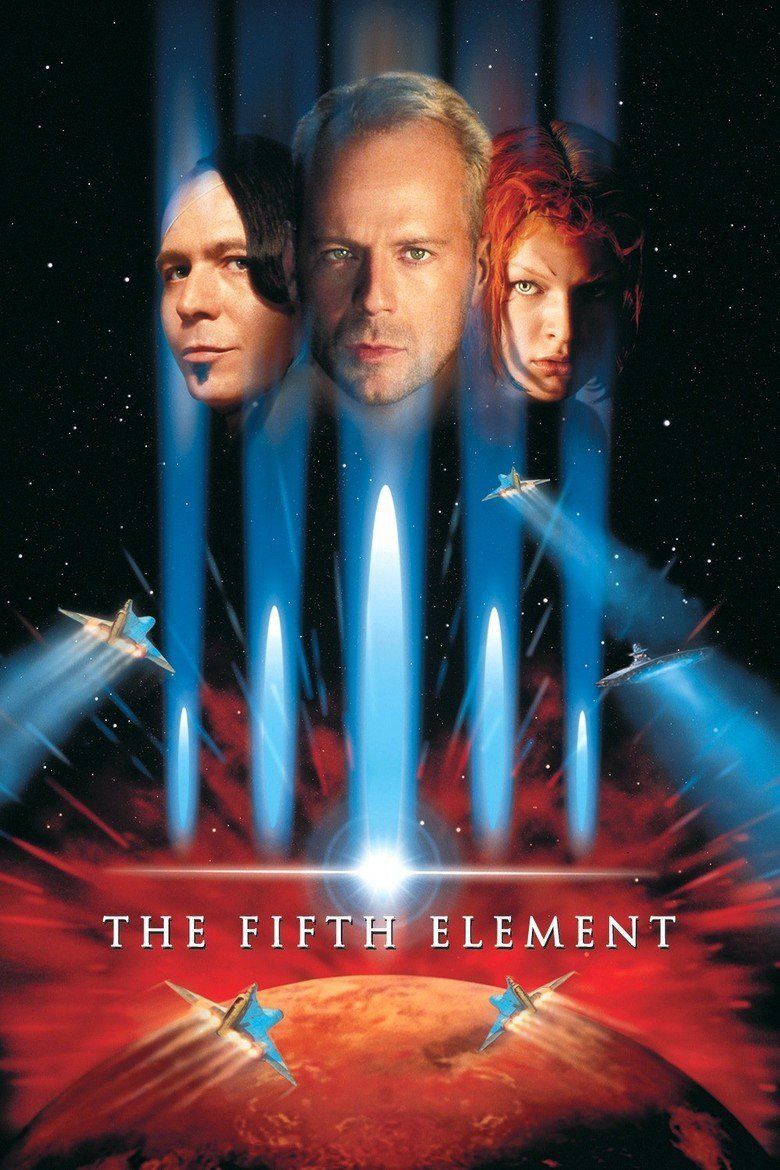 | ||||||||||||||||||||||||||||||||||
Release date 7 May 1997 (1997-05-07) Cast (Korben Dallas), (Leeloo), (Jean-Baptiste Emmanuel Zorg), (Father Vito Cornelius), (Ruby Rhod), (Billy) Similar movies Related Luc Besson movies Tagline There is no future without it. | ||||||||||||||||||||||||||||||||||
In the 23rd century, a New York City cabbie, Korben Dallas (Bruce Willis), finds the fate of the world in his hands when Leeloo (Milla Jovovich) falls into his cab. As the embodiment of the fifth element, Leeloo needs to combine with the other four to keep the approaching Great Evil from destroying the world. Together with Father Vito Cornelius (Ian Holm) and zany broadcaster Ruby Rhod (Chris Tucker), Dallas must race against time and the wicked industrialist Zorg (Gary Oldman) to save humanity.
Contents
- Plot
- Themes
- Production
- Effects
- Soundtrack
- Initial screening
- Box office
- Critical response
- Legacy and related media
- Accolades
- Home media
- References
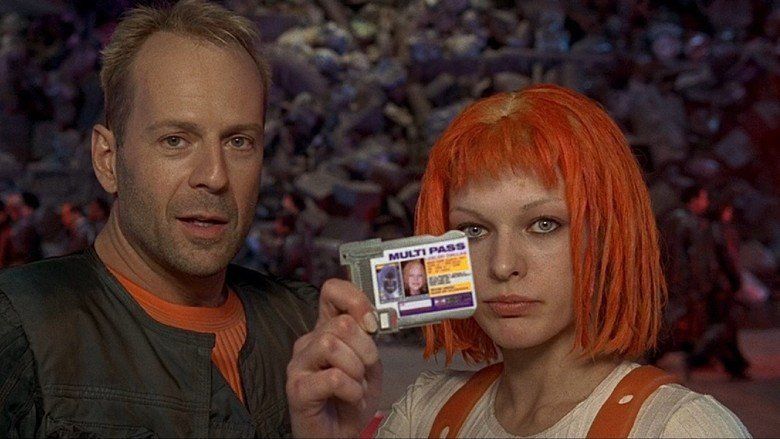
The Fifth Element (French: ) is a 1997 English-language French science fiction action film directed and co-written by Luc Besson. It stars Bruce Willis, Gary Oldman and Milla Jovovich. Mostly set in the 23rd century, the films central plot involves the survival of planet Earth, which becomes the responsibility of Korben Dallas (Willis), a taxicab driver and former special forces major, after a young woman (Jovovich) falls into his cab. Dallas joins forces with her to recover four mystical stones essential for the defence of Earth against an impending attack.

Besson started writing the story that became The Fifth Element when he was 16 years old; he was 38 when the film opened in cinemas. Besson wanted to shoot the film in France, but suitable locations could not be found; filming took place instead in London and Mauritania. Comics writers Jean Giraud and Jean-Claude Mezieres, whose comics provided inspiration for parts of the film, were hired for production design. Costume design was by Jean Paul Gaultier.
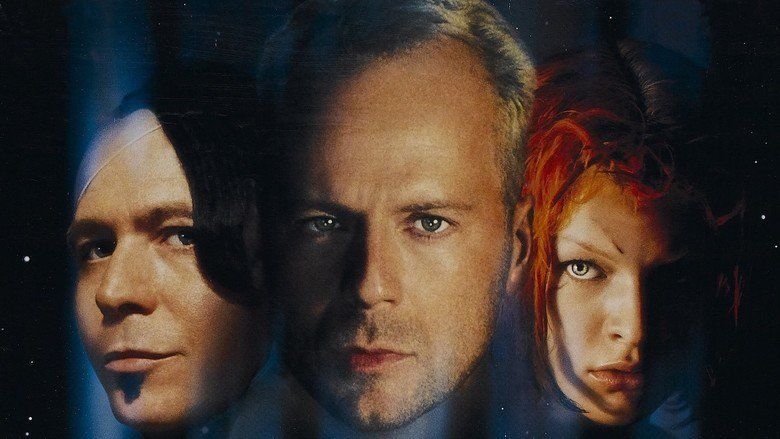
The Fifth Element received mainly positive reviews, although it tended to polarise critics. It has been called both the best and worst summer blockbuster of all time. The film was a financial success, earning more than $263 million at the box office on a $90 million budget. At the time of its release it was the most expensive European film ever made, and it remained the highest-grossing French film at the international box office until the release of The Intouchables in 2011.
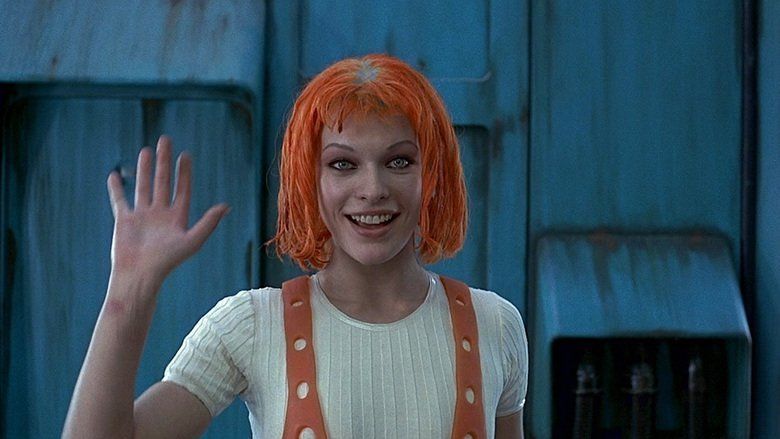
It’s the year 2257 and a taxi driver has been unintentionally given the task of saving a young girl who is part of the key that will ensure the survival of humanity. The Fifth Element takes place in a futuristic metropolitan city and is filmed in a French comic book aesthetic by a British, French and American lineup.
Plot
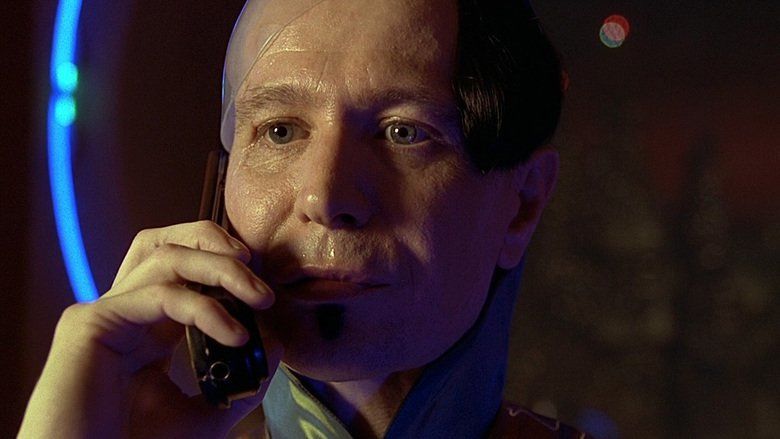
In 1914, aliens known as Mondoshawans arrive at an ancient Egyptian temple to collect, for safekeeping, the only weapon capable of defeating a great evil that appears every 5,000 years. The weapon consists of four stones, representing the four classical elements, and a sarcophagus containing a fifth element in the form of a human, which combines the power of the other four elements into a divine light capable of defeating the evil. The Mondoshawans promise their human contact, a priest from a secret order, that they will come back with the element stones in time to stop the great evil when it returns.

In 2263, the great evil appears in deep space in the form of a giant ball of black fire, and destroys an attacking Earth spaceship. The Mondoshawans current contact on Earth, priest Vito Cornelius (Ian Holm), informs the President of Earth (Tom Lister Jr.) of the history of the great evil and the weapon that can stop it. As the Mondoshawans return to Earth they are ambushed by Mangalores, a race hired by the industrialist Jean-Baptiste Emanuel Zorg (Gary Oldman), who has been instructed by the great evil to acquire the stones.
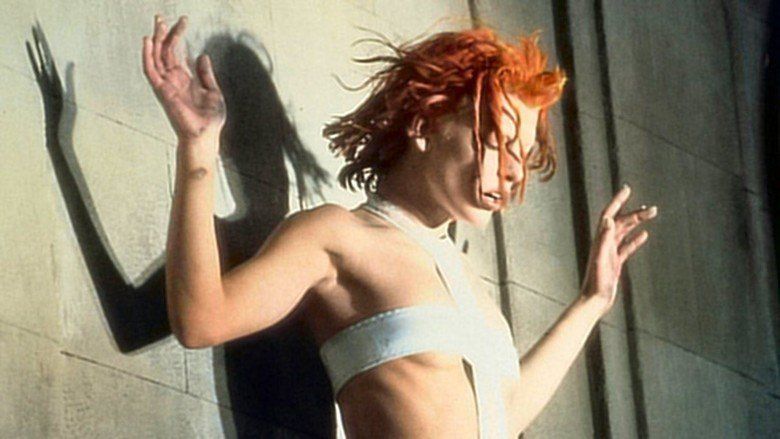
The Mondoshawans spacecraft is destroyed, though the stones are not on board; the only item recovered is a hand of The Fifth Element. Scientists take it to a New York City laboratory and use it to reconstruct a humanoid woman who takes the name Leeloo (Milla Jovovich). Terrified of the unfamiliar surroundings, she escapes confinement and jumps off a ledge, crashing into the flying taxicab of Korben Dallas (Bruce Willis), a former major in the special forces.
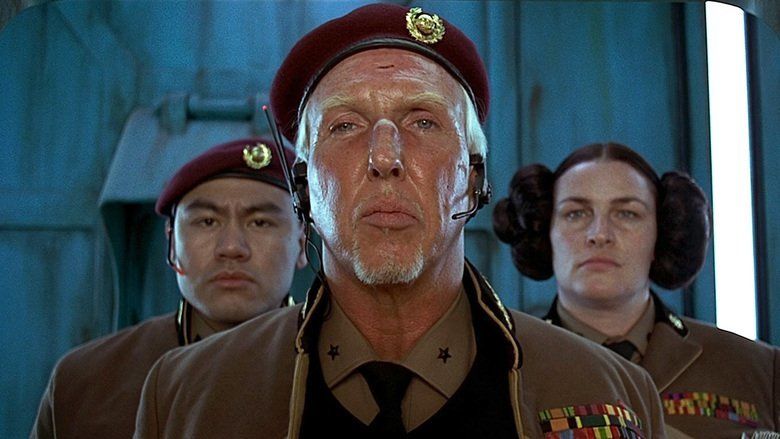
Dallas delivers Leeloo to Cornelius and his apprentice, David (Charlie Creed-Miles), whereupon Cornelius learns that the Mondoshawans entrusted the four element stones to the alien Diva Plavalaguna (Maiwenn Le Besco), an opera singer. Zorg kills many of the Mangalores because of their failure to obtain the stones, but their compatriots determine to seize the artifacts for themselves. Upon learning from the Mondoshawans that the stones are in Plavalagunas possession, General Munro (Brion James), Dallas former superior, re-enlists Dallas and orders him to travel undercover to meet Plavalaguna on a luxury intergalactic cruise; Dallas takes Leeloo with him. Meanwhile, Cornelius instructs David to prepare the ancient temple designed to house the stones, then stows away on the space plane transporting Dallas to the cruise liner.

Plavalaguna is killed when the Mangalores attack the ship, but Dallas succeeds in retrieving the stones. During his struggle with the Mangalores he kills their leader. After shooting and seriously wounding Leeloo, Zorg finds a carrying case which he presumes contains the stones, and takes it back to his spacecraft, leaving behind a time bomb that forces the liners occupants to evacuate. Discovering the case to be empty, Zorg returns to the ship and deactivates his bomb, but a dying Mangalore sets off his own device, destroying the ship and killing Zorg. Dallas, Cornelius, Leeloo, and talk-show host Ruby Rhod (Chris Tucker) escape with the stones aboard Zorgs spacecraft.
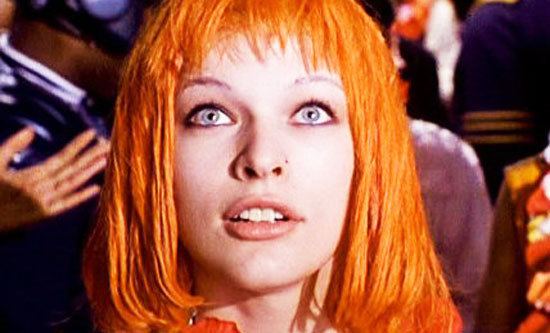
The four join up with David at the weapon chamber in the Egyptian temple as the great evil approaches. They activate the stones, but having witnessed and studied so much violence, Leeloo has become disenchanted with humanity and refuses to cooperate. Dallas confesses his love for Leeloo and kisses her. In response, Leeloo combines the power of the stones and releases the divine light; the great evil, now dormant, becomes another moon in Earth orbit.
Themes
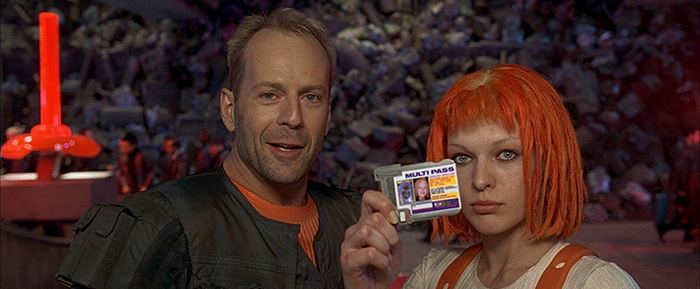
In an interview Besson stated The Fifth Element was not a "big theme movie", although the films theme was an important one. He wanted viewers to reach the point where Leeloo states "Whats the use of saving life when you see what you do with it?", and agree with her. Jay P. Telotte, writing in the book Science Fiction Film, credited the film with exploring the theme of political corruption.
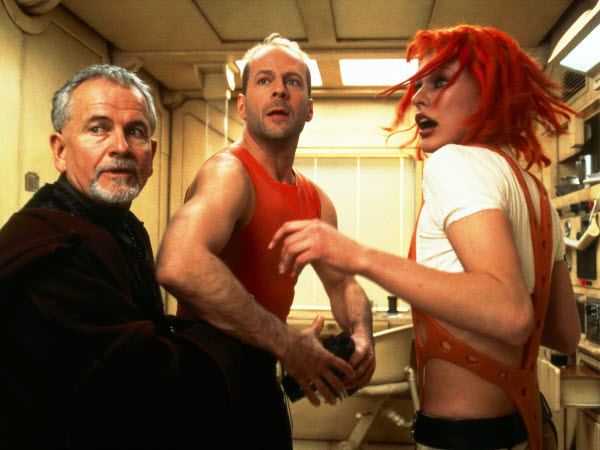
An article by Brian Ott and Eric Aoki in the feminist journal Womens Studies in Communication considered gender to be one of the films main themes. The authors accused the film of erasing women from the introductory scenes, noting that Leeloos reconstruction marked only the second appearance of a female in the films first 20 minutes; the other is an androgynous, speechless presidential aide. When females appear in the film, they do so as passive objects, such as the sexualised flight and McDonalds attendants; or stripped of their femininity, such as the "butch" Major Iceborg. Stefan Brandt, in the book Subverting Masculinity, also said that the film "echoes stereotypical beliefs about gender" of all females in the film, including Leeloo, who leaves her passive role in the film only during her fight with the Mangalores. With the exception of Tiny Listers portrayal of the President, all males in the film were considered to be as unmanly as possible in various ways, such as Ruby Rhods effeminacy, Vito Corneliuss clumsiness, and General Munros stupidity; their purpose was to make Korbens masculinity appear "god-like" by comparison.
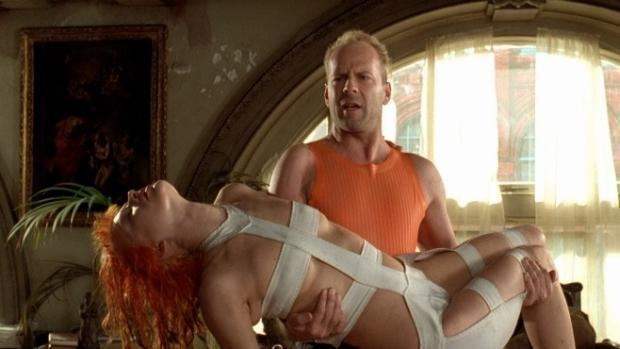
In the book The Films of Luc Besson, Susan Hayward considered The Fifth Element to be a classic story of a man "making his break from the tribe, proving his manhood, over-throwing the malevolent forces and killing the chief, finally to reap the rewards of security and marriage". Korbens journey, however, is under threat not only from the Mangalores and Zorg, but also from Leeloo, who only relents and helps him at the last minute, accepting his declaration of love. The love story within The Fifth Element was considered to be one of the main narratives in the film, and it faces the same deadline as the main storyline. Hayward also considered the issue of environmental damage, in so far as waste and pollution are visible throughout the film. Whereas science fiction films often show a world wherein some new technology or threat either surpasses or fails humanity, The Films of Luc Besson included The Fifth Element amongst the minority of science fiction films that "hold up a mirror" and show humankind as responsible. The film was said to be skeptical of capitalist consumerism, in so far as the gadgets in Zorgs office make an unhealthy obsession of his lust for technology. The tension between technology and man is treated as a problem requiring a final resolution.
Production
As a teenager, Besson envisioned the world of The Fifth Element in an attempt to alleviate boredom. He began writing the script when he was 16, though it was not released in cinemas until he was 38. The original storyline was set in the year 2300, and was about a "nobody" named Zaltman Bleros (later renamed Korben Dallas) who wins a trip to the Club Med resort on the planet Fhloston Paradise. There he meets Leeloo, a "sand-girl" who has the "beauty of youth" despite being over 2,000 years old. Besson continued to work on and modify the storyline for years; by the time his film Atlantis was released in 1991 he had a 400-page script. Nicolas Seydoux and Patrice Ledoux from Gaumont were the first people to take on the project. In November 1991, while looking for actors for the film, Besson met French comics creators Jean Giraud and Jean-Claude Mezieres and recruited them for the films production design. Giraud and Mezieress comics were a major source of inspiration for Bessons futuristic New York City. Mezieres wrote the book The Circles of Power, which features a character named STraks, who drives a flying taxicab through the congested air traffic of the vast metropolis on the planet Rubanis. Mezieres showed images of the flying taxi to Besson, who was inspired to change the background of Korben Dallas from a worker in a rocketship factory to that of a taxi driver who flies his cab around a Rubanis-inspired futuristic New York. Five other artists were hired for the project, and Jean Paul Gaultier was hired to design the films costumes. The team spent a year creating over 8,000 drawings, during which time Besson approached both Bruce Willis and Mel Gibson for the lead role. Willis expressed interest, though he was reluctant to take on the role as the film was considered risky after his previous two films, Hudson Hawk and Billy Bathgate, had been received poorly; Gibson eventually turned down the role. While the team impressed film companies with their designs, they struggled to find one willing to take on the films budget of almost $100 million. In December 1992 production of the film stopped without any prior warning, and the team disbanded.
Besson went on to direct the commercially successful film Leon: The Professional, which was released in September 1994. While shooting and releasing Leon, he continued to work on the script for The Fifth Element, shortening it and reducing the films budget to $90 million before attempting to find a studio willing to produce it. Columbia Pictures, who had a partnership in Leon, agreed to finance the film. By this time Besson had decided to go with a lesser known lead actor in order to save on production costs. Besson was in Barry Josephsons office when Willis called regarding a different film. Besson asked to speak to Willis "just to say hello", and told him that The Fifth Element was finally going ahead, explaining the decision to go with a less expensive actor. After a short silence, Willis stated "If I like the film, we can always come to an arrangement"; he agreed to take on the role after reading the script. Production of the film commenced in early August 1995. Besson traveled to various places for casting, including Paris, London and Rome. He chose to hire Gary Oldman, who had starred in Leon, for the role of Zorg, describing Oldman as "one of the top five actors in the world." For the character Leeloo, Besson chose Milla Jovovich from the 200 to 300 applicants he met in person. The "Divine Language" spoken in the film by Leeloo is a fictional language with only 400 words, invented by Besson. Jovovich and Besson held conversations and wrote letters to each other in the language as practice. Besson was in a relationship with Maiwenn Le Besco, who played the role of Diva Plavalaguna, for six years when filming commenced; however, he left her for Jovovich during filming. Jovovich and Besson later married, but divorced in 1999.
Despite wishing to shoot the film in France, Besson could not find suitable facilities and "with a heavy heart" instead filmed in London. It was primarily filmed at Pinewood Studios on seven soundstages including the 007 Stage. Construction of sets began in October 1995. The opera scene was filmed at the Royal Opera House. Scenes depicted as being in Egypt were filmed in Mauritania; the first shoot for the film, a background shot of the desert, occurred there on 5 January 1996. Filming with actors began in late January, and was completed 21 weeks later. Willis finished filming on 16 May, while Oldman only commenced filming the following week; the films protagonist (Korben) and antagonist (Zorg) never actually share any screen time. Despite being filmed in London, The Fifth Element was a French production, and went on to become the costliest European film ever made at the time. The buildings in New York were derived from both metabolist-inspired masses of modular apartments from the 1960s, and the futuristic designs of architect Antonio SantElia in the 1910s. Besson demanded that most of the action shots in the film take place in broad daylight, as he was reportedly tired of the dark spaceship corridors and dimly lit planets common in science fiction films, and wanted a brighter "cheerfully crazy" look as opposed to a gloomy realistic one. Gaultier designed every one of the 900 costumes worn by extras in the films Fhloston Paradise scenes, and checked each costume every morning. His designs, described as "intellectually transgressive", were said to challenge sexuality and gender norms. A single jacket he designed for the film cost $5,000.
The original name of the character Ruby Rhod was Loc Rhod. The name appears in both the original script and in the novelisation of the film. Speculation has been raised that the name change was a play on information in the periodic table. Rubidium is the first of the Period 5 elements, and exactly halfway down that row is the element Rhodium. Taking the first half of each element yields "Rubi Rhod". Others have speculated his name is a play on his gender bending personality; having a feminine first name and phallic surname. The term "ruby rod" also refers to the essential component of the first working laser design.
Effects
Three different teams handled the three different types of special effects used in the film. Nick Allder was placed in charge of mechanical and pyrotechnical effects, Nick Dudman was placed in charge of creature effects and Mark Stetson headed the visual effects team. Visual effects company Digital Domain was hired for the film, and Karen Goulekas was given the role of digital effects supervisor. Alias, Autodesk Softimage, Arete, Side Effects Prisms, RenderMan, as well as in-house software, were used by Digital Domain to create effects. Some individual shots used a combination of live action, scale models, computer-generated imagery and particle systems. The lanes of traffic in the scenes in New York City were created with particle systems:
We had maybe 80 cityscape shots with CG cars hurtling around, and you couldnt animate them all by hand because there were just too many of them in each scene ... When the cars turned a corner, the velocity changes were automatic, so the animator didnt have to worry about that. They just planned the moves in a very blocky way, and the mathematics smoothed out the rest.
Amongst the scale models used for filming were the buildings seen in New York City. Dozens of apartment blocks and 25 skyscrapers, some 20 feet (6.1 m) high, were constructed in 1/24th scale. It took a team of 80 workers five months to build the models used in the film. The windows of the buildings were cited by the team as one of the most time-consuming tasks, along with details behind the windows, such as furniture, blinds, lightboxes and tiny pieces of flat artwork. Virtual sets built within digital environments were created to enhance the use of miniatures. Motion control cameras moved throughout the scale sets, and the data they collected was exported to track and generate the CG animation and particle systems. Other techniques used in the film included digital matte paintings for backgrounds and the NURBS mathematical model for certain animations, including the sequence in which Leeloos body is reconstructed.
Soundtrack
The Fifth Element is one of Bessons films which have been described as "intrinsically musical"; some kind of music is playing during about 90 percent of the film. The films score was composed by Eric Serra. He relies heavily on the use of orchestral textures, such as the oboe and strings heard as the surgeons prepare to regenerate Leeloo, and the pizzicato as she is reconstructed. Serra also used many exotic influences, such as the Stalinist fanfare heard before the spaceport sequence, the reggae piece played in preparation for the flight, and the hula music that greets the passengers as they arrive in Fhloston. More conventional scoring techniques are present in the leitmotif that first appears when professor Pacoli mentions the fifth element, the militaristic snares as the warship prepares to attack the dark planet, and the Mahlerian funereal piece heard when Leeloo learns about war. The music used for the taxicab chase scene, titled "Alech Taadi" by Algerian performer Khaled, is excluded from the film soundtrack, but is available on Khaleds album Nssi Nssi.
The Diva Dance opera performance featured music from Gaetano Donizettis Lucia di Lammermoor: "Il dolce suono", the mad scene of Act III, Scene 2. It is one of the few pieces of music in the film that is diegetic. It was sung by Albanian soprano Inva Mula, while the role of Plavalaguna was played by French actress Maiwenn Le Besco. Part One (titled "Lucia di Lammermoor") and Part Two (titled "The Diva Dance") of this piece are included as separate tracks on The Fifth Element soundtrack, but are sequenced to create the effect of the entire performance seen in the film. The end of Part One blends into the beginning of Part Two, creating a smooth transition between the two tracks.
Released as an album under Virgin Records, the soundtrack peaked at No. 99 on the Billboard 200. More than 200,000 copies of the lengthy soundtrack were sold in France alone. Rodney Batdorf of AllMusic gave the album three out of five stars, stating it was "diverse and accomplished, and it is just as effective outside of the film as it is within it." A review from Filmtracks.com also awarded the album three out of five stars.
Initial screening
The film premiered on 7 May 1997 at the 1997 Cannes Film Festival, where it was selected as the opening film. Gaumont built an area for the screening that was over 100,000 square feet (9,300 m2). Guests were given a "Fifth Element" Swatch, which was used as their ticket for entry. The event featured a futuristic ballet, a fashion show by Jean Paul Gaultier, and fireworks. Gaumont spent between US $1 million and $3 million on the event, a record at the time.
Box office
The film debuted at number 1 in the US, earning $17 million on its opening weekend. It went on to become a box-office success, grossing over $263 million, almost three times its budget of $90 million. Seventy-six percent of the receipts for The Fifth Element were from markets outside the United States, and it was the ninth highest-grossing film of the year worldwide. It was the most successful film at the box office in France in 1997, with more than 7.69 million seeing the film. In Germany the film was awarded the Goldene Leinwand, a sales certification award for selling more than three million tickets at the box office. The Fifth Element went on to become the highest grossing French film at the foreign box-office, a record it held for 16 years until the release of The Intouchables in 2011.
Critical response
The Fifth Element holds a 71 percent approval rating at Rotten Tomatoes, based on 58 reviews. The sites consensus reads: "Visually inventive and gleefully over the top, Luc Bessons The Fifth Element is a fantastic piece of pop sci-fi that never takes itself too seriously." It has a weighted score of 52/100 at Metacritic, based on 22 professional reviews, indicating "mixed or average" reviews.
The Fifth Element polarised critics on release. Kevin Thomas of the Los Angeles Times described the film as an "elaborate, even campy sci-fi extravaganza, which is nearly as hard to follow as last years Mission: Impossible." He concluded that The Fifth Element was "a lot warmer, more fun and boasts some of the most sophisticated, witty production and costume design you could ever hope to see." On film review show At the Movies, both Roger Ebert and Gene Siskel gave the film a "thumbs up"; in his own review for the Chicago Sun-Times, Ebert gave the film 3 stars out of 4, calling it "One of the great goofy movies", and concluding, "I would not have missed seeing this film, and I recommend it for its richness of imagery. But at 127 minutes, which seems a reasonable length, it plays long."
The film was, however, subject to a number of harsh reviews that expressed disapproval of its overblown style. Todd McCarthy of Variety wrote, "A largely misfired European attempt to make an American-style sci-fi spectacular, The Fifth Element consists of a hodgepodge of elements that dont comfortably coalesce." David Edelstein of Slate was even more critical, saying, "It may or may not be the worst movie ever made, but it is one of the most unhinged."
Chris Tuckers performance as Ruby Rhod also polarised critics. He was praised in the Los Angeles Times and in Time; the latter called him "the summers most outrageous special effect." Josh Winning of GamesRadar, however, singled out Tuckers performance as the low point of the film, ranking it as No. 20 on his 2011 list, "50 Performances That Ruined Movies."
Legacy and related media
The film has been described in various publications as a science fiction cult classic. However film critic Mark Kermode reported that The Fifth Element was one of the most divisive films among his readers, regarded as both the best and the worst summer blockbuster of all time. Kermode recalled his own experience: "I remember very clearly being in Cannes when [The] Fifth Element was first played, and it really divided the audience." Stephen Cass of Discover ranked the film the third-best science fiction movie on subscription service Hulu, writing, "People seem to either like or loathe The Fifth Element ... Lavish visuals and entertaining performances from Bruce Willis, Milla Jovovich, and Gary Oldman make this movie worth watching." In some circles the film has gained a "so-bad-its-good" status; Meredith Woerner of io9 listed The Fifth Element as one of "The 20 Best Worst Science Fiction Movies of All Time". In 2007 the Visual Effects Society placed The Fifth Element at No. 50, tied with Darby OGill and the Little People, on their list of the 50 most influential visual effects films of all time. In 2014, Time Out listed the film at No. 42 on their "100 best sci-fi movies" list.
Willis spoke favourably of the film in a 1999 interview, concluding "it was a real fun movie to make." Tucker and Jovovich also spoke favourably of both their experiences making the film and working with Besson in interviews on the Ultimate Edition DVD; Jovovich described Besson as "the first really amazing director I had worked with". Asked in a 2014 interview if he liked the film, Gary Oldman stated, "Oh no. I cant bear it." He had explained in 2011: "It was me singing for my supper because Luc had come in and partly financed [my film] Nil by Mouth."
Alejandro Jodorowsky and Jean Giraud sued Besson after the film was released, claiming The Fifth Element had plagiarised their comic The Incal. Giraud sued for 13.1 million euros for unfair competition, 9 million euros in damages and interest and two to five percent of the net operating revenues of the film. Jodorowsky sued for 700,000 euros. The case was dismissed in 2004 on the grounds that only "tiny fragments" of the comic had been used and also due to the fact that Giraud had been hired by Besson to work on the film before the allegations were made.
A novel adaptation of The Fifth Element, written by Terry Bisson, was published by HarperPrism in 1997. There were rumors after the films release that it would be followed by a sequel, tentatively titled Mr. Shadow. In 2011, Besson stated that a sequel was never planned, and that he has no desire to make one.
A video game adaptation of The Fifth Element was created by Activision for the PlayStation game console and PC in 1998. The PlayStation version was generally met with negative reviews, though the PC version was better received. Lauren Fielder from GameSpot called the PlayStation version "quite possibly the worst game Ive ever played." Doug Perry from IGN commented: "Take Tomb Raider, add in Leeloo Multipass and boring puzzles, and youve got Fifth Element." A racing game based on the film, New York Race, was released in 2001. Eurogamer gave the game 6 out of 10, concluding: "New York Race is a fun little arcade racer which oozes style, but its something youll grow tired of extremely quickly and as such remains fun only in short bursts."
Accolades
The Fifth Element was nominated for Best Sound Editing at the 70th Academy Awards, and for Best Sound Editing at the 1998 Golden Reel Awards, but lost to Titanic in both cases. It won the BAFTA Award for Best Special Visual Effects, and the Lumieres Award for Best Director. It was nominated for seven Cesar awards, winning three: Best Director, Best Cinematography and Best Production Design. It was nominated for Film of the Year at the 1997 European Film Awards, as well as the Hugo Award for Best Dramatic Presentation, and the Satellite Award for Best Visual Effects. Thierry Arbogast was awarded the Technical Grand Prize at the 1997 Cannes Film Festival for his work on both The Fifth Element and Shes So Lovely. The film received four Saturn Award nominations: Best Science Fiction Film, Best Costume, Best Special Effects, and Best Supporting Actress for Milla Jovovich. Jovovichs fight against the Mangalores was nominated for the MTV Movie Award for Best Fight, and the actress was also nominated for Best Actress – Newcomer at the Blockbuster Entertainment Awards.
Conversely, Jovovich received a Razzie nomination for Worst Supporting Actress, and Chris Tucker was nominated for Worst New Star for his performances in both The Fifth Element and Money Talks.
Home media
The original home video release of The Fifth Element took place in North America on 10 December 1997, on VHS, LaserDisc, and DVD. The original DVD presented the film in its original 2.39:1 anamorphic widescreen format though carried no special features. The film was released in Sonys Superbit format in October 2001. In his review, Conrad Jeremy from IGN gave the picture quality of the original DVD release 9 out of 10, though awarded the Superbit version a perfect score for picture quality. Overall the Superbit version was given 8 out of 10; the final score was brought down by the versions complete lack of special features.
An "Ultimate Edition" set of two DVDs was released on 11 January 2005. The only difference between the Superbit version and the Ultimate Edition disc one is the addition of a "fact track", which when turned on displays trivia about the film, cast and crew as the film plays. The second disc provides various special features, focusing on visual production, special effects, fashion in the film, featurettes and interviews with Willis, Jovovich, and Tucker, as well as featurettes on the four different alien races in the film and Diva Plavalaguna. Ian Jane of DVD Talk praised the Ultimate Edition for its special features.
The first Blu-ray Disc release of the film on 20 June 2006 was criticised as having poor picture quality by Blu-ray standards, and for its lack of special features. In what has been called "an extremely rare move" Sony responded to complaints by making a remastered Blu-ray version available, released on 17 July 2007, and also offered a replacement exchange program for customers unhappy with the original Blu-ray release. Ben Williams from Blu-ray.com stated the remastered version "absolutely" made up for the lacklustre initial release and praised its high video and audio quality; however, he criticised the continued lack of special features.
References
The Fifth Element WikipediaThe Fifth Element IMDbThe Fifth Element Rotten TomatoesThe Fifth Element Roger EbertThe Fifth Element MetacriticThe Fifth Element themoviedb.org
